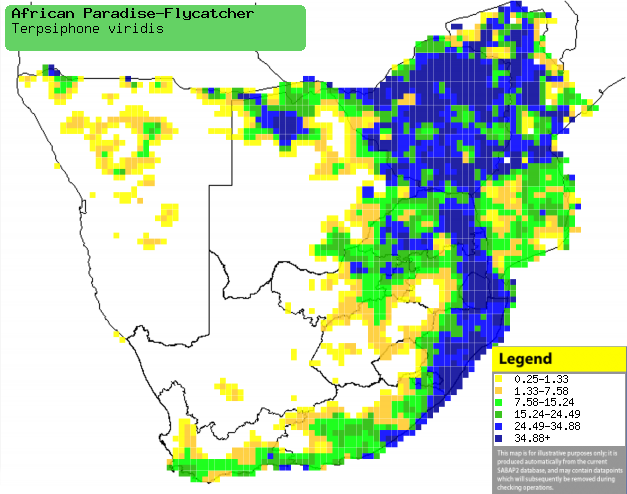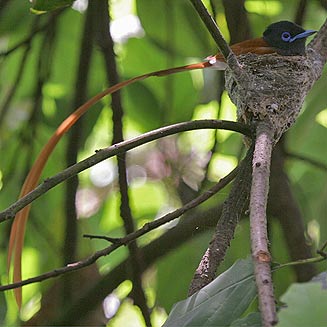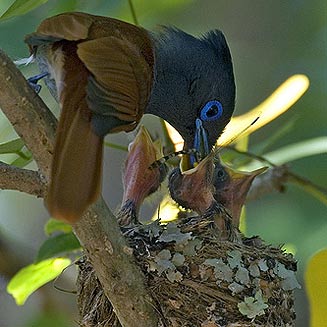|
Terpsiphone viridis (African
paradise-flycatcher)
ParadysvlieŽvanger [Afrikaans]; Ujejane, Unomaphelana
[Xhosa]; iNzwece, uVe [Zulu]; Kapantsi-ea-meru [South Sotho]; Mmakgwadi [North
Sotho]; Nglhazi [Tsonga]; Afrikaanse paradijsmonarch [Dutch]; Tchitrec d'Afrique
[French]; Paradiesschnšpper [German]; Papa-moscas-do-paraŪso [Portuguese]
Life
> Eukaryotes >
Opisthokonta
> Metazoa (animals) >
Bilateria >
Deuterostomia > Chordata >
Craniata > Vertebrata (vertebrates) > Gnathostomata (jawed
vertebrates) > Teleostomi (teleost fish) > Osteichthyes (bony fish) > Class:
Sarcopterygii (lobe-finned
fish) > Stegocephalia (terrestrial
vertebrates) > Tetrapoda
(four-legged vertebrates) > Reptiliomorpha > Amniota >
Reptilia (reptiles) >
Romeriida > Diapsida > Archosauromorpha > Archosauria >
Dinosauria
(dinosaurs) > Saurischia > Theropoda (bipedal predatory dinosaurs) >
Coelurosauria > Maniraptora > Aves
(birds) >
Order: Passeriformes > Family: Monarchidae
Distribution and habitat
Occurs across sub-Saharan Africa, absent only from very
arid areas. In southern Africa, it is common from Zimbabwe, Mozambique and
Botswana to large areas of South Africa, all the way down to Cape Town. It
generally prefers woodland and forest, such as Brachystegia (miombo)
woodland, evergreen forest and suburban gardens.
|
 |
|
Distribution of African paradise-flycatcher in southern Africa,
based on statistical smoothing of the records from first SA Bird Atlas
Project (©
Animal Demography unit, University of
Cape Town; smoothing by Birgit Erni and Francesca Little). Colours range
from dark blue (most common) through to yellow (least common).
See here for the latest distribution
from the SABAP2. |
Brood parasites
It has been recorded as host of the following birds:
Movements and migrations
It is a breeding migrant with two separate subspecies, each
arriving in different areas and during different times of the year:
-
T. v. grantii breeds around the coast of South
Africa through to most of Mozambique. It arrives around September, staying
until about April, although it varies greatly year-to-year.
-
T. v. plumbeiceps occupies the rest of its
southern African distribution, arriving mainly in October and also leaves
during April.
Food
It mainly eats invertebrates, such as moths, termite alates,
beetles and flies, occasionally eating small berries. It uses a variety of
foraging techniques, catching most of its prey on the wing, although it
regularly gleans insects from leaves and branches. The following food items have
been recorded in its diet:
- Insects
- Small berries (rarely)
Breeding
- Both sexes participate in the construction of the nest, usually sharing
the workload equally. It consists of a small cup of twigs and bark held
together with spider web, decorated with lichen and often a "trail" of
spider web and leaves dangling from its base.
- Egg-laying season peaks from October-December.
- It lays 1-4 eggs, which are incubated by both sexes for about 11-19
days. They change shifts every 20-60 minutes, although the female often does
most of the incubating at night.
 |
 |
| African paradise-flycatcher male sitting on nest.
[photo Stephen
Davis ©] |
African paradise-flycatcher feeding chicks. [photo
Arno Meintjes ©] |
- The chicks are brooded almost constantly for the first day or so, while
they are fed small portions of insect prey. As they get older, their parents
brood and feed them less often until they leave the nest at about 10-16 days
old. They stay in a family group with their parents until another clutch of
eggs is laid, at which point they become fully independent.
Threats
Not threatened, in fact common in large areas of
sub-Saharan Africa.
References
-
Hockey PAR, Dean WRJ and Ryan PG 2005. Roberts
- Birds of southern Africa, VIIth ed. The Trustees of the John Voelcker
Bird Book Fund, Cape Town.
|
